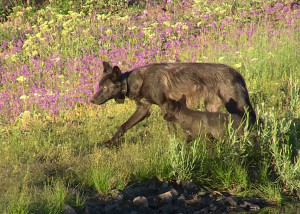December 30, 2015 — Three conservation groups filed a legal challenge today to the removal of protection from gray wolves under Oregon's Endangered Species Act. According to the challenge, the 4-2 decision by the Oregon Fish and Wildlife Commission to delist wolves violated the law by failing to follow best available science and prematurely removing protections before wolves are truly recovered. With only about 80 known adult wolves mostly confined to one small corner of the state, Oregon’s wolf population is far from recovery, according to leading scientists.
FOR IMMEDIATE RELEASE
December 30, 2015
Contact:
Nick Cady, Cascadia Wildlands / 314-482-3746, nick@cascwild.org
Noah Greenwald, Center for Biological Diversity / 971-717-6403, ngreenwald@biologicaldiversity.org
Rob Klavins, Oregon Wild / 541-886-0212, rk@oregonwild.org

Photo taken July 6, 2013 of OR17 with a 2013 pup of the Imnaha pack. Subadult wolves assist in the raising of the pups. Photo courtesy of ODFW.
PORTLAND, Ore.— Three conservation groups filed a legal challenge today to the removal of protection from gray wolves under Oregon’s Endangered Species Act. According to the challenge, the 4-2 decision by the Oregon Fish and Wildlife Commission to delist wolves violated the law by failing to follow best available science and prematurely removing protections before wolves are truly recovered. With only about 80 known adult wolves mostly confined to one small corner of the state, Oregon’s wolf population is far from recovery, according to leading scientists.
“It’s simply too soon to remove protections for Oregon’s wolves,” said Noah Greenwald, Endangered Species Program director at the Center for Biological Diversity. “It’s not rocket science that roughly 80 wolves in 12 percent of suitable habitat in Oregon does not equal a recovered population. The gray wolf remains endangered, and protections should never have been removed.”
Like the federal law, the Oregon Endangered Species Act requires protection of species when they are at risk in any significant portion of their range. After being extirpated in the mid-20th century, wolves have begun to make a comeback in Oregon but remain absent from nearly 90 percent of the state’s potential habitat. Wolves have only been present west of the Cascades since the wolf known as OR-7 (Journey) trekked across the state in 2011. OR-7 found a mate and established the Rogue pack in southwestern Oregon, the only known pack in the portion of Oregon where wolves are still recognized as federally endangered. But the U.S. Fish and Wildlife Service is proposing to strip wolves of federal protections in most of the lower 48, including where the Rogue pack lives, making the need for continued state protections all the more essential.
“Oregon’s endangered species act has provided critical backbone protections for gray wolves,” said Nick Cady, legal director of Cascadia Wildlands. “Oregon law with its science requirements wisely protects endangered species in this state from becoming political gambling chips. The commission’s decision to delist wolves is plain political kowtowing to the livestock industry. This decision was not based in science, it was not based on Oregon’s conservation values, it violated the law, and it will not survive scrutiny.”
Hundreds of citizens testified at hearings across the state and more than 20,000 public comments were submitted during the status review. More than 95 percent were in favor of maintaining protections.
“Most Oregonians value native wildlife, and wolf recovery has the potential to be a tremendous conservation success story,” said Rob Klavins, a conservation advocate for Oregon Wild in Wallowa County. “We look forward to the day we can celebrate the recovery of wolves in Oregon, but in a rush to declare ‘Mission Accomplished,’ the state caved to political pressure. If there were fewer than 100 elk or salmon or eagles left in the state, the agency would be scrambling to protect them. Wolves are being treated differently.”
Oregon’s endangered species act requires that the listing or delisting of a species is based upon the best available, verifiable science. More than two dozen scientists submitted comments to the state highly critical of the delisting proposal. The scientists strongly criticized the state’s basis for delisting, documented that the state has not taken appropriate steps to lessen threats to wolves and concluded that wolves remain at risk and should not be delisted at this time.
Excerpts from scientists’ comment letters submitted to the state during the public comment period leading up to the commission’s vote to delist wolves:
“… it is untenable to think that being extirpated from nearly 90% of current suitable range … would qualify the species for delisting.”
—John Vucetich, Professor of Wildlife, Michigan Technological University; Jeremy T. Bruskotter, Associate Professor, School of Environment and Natural resources, The Ohio State University; Michael Paul Nelson, Ruth H. Spaniol Chair of Renewable Resources and Professor of Environmental Ethics and Philosophy, Oregon State University.
“It is my expert opinion that the existing [population viability analysis] is fundamentally flawed and does not provide an adequate or realistic assessment of the Oregon wolf population to meet Criterion 1 or 2 or 4, therefore the delisting requirements are not supported by the results of the [population viability analysis] as it was performed.”
—Derek E. Lee, Principal Scientist, Wild Nature Institute, Hanover, N.H.
“ODFW finds that the wolf is not now (and is not likely in the foreseeable future to be) in danger of extinction throughout any significant portions of its range in Oregon. . . . The reality is that the wolf is past being in danger of extinction throughout many significant portions of its range in OR because it occupies only 12% of its suitable habitat (so is extinct in 88% of its suitable habitat). The interpretation of this section of OR ESA by ODFW is an illegitimate interpretation that . . . also runs contrary to recent scientific literature on significant portion of range.”
—Guillaume Chapron, Ph.D., Associate Professor, Grimso Wildlife Research Station, Swedish University of Agricultural Sciences, Riddarhyttan, Sweden.

